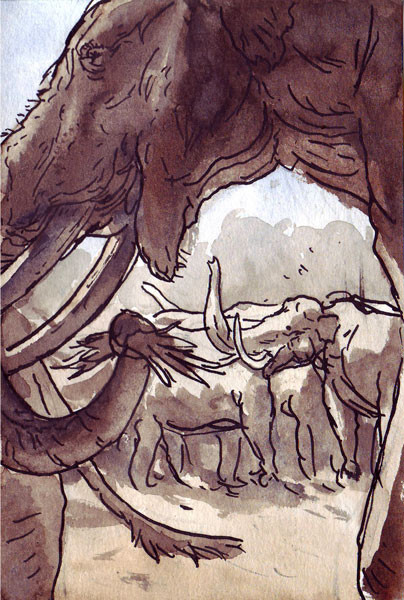HOME | DD
 povorot — Fun-gulates
povorot — Fun-gulates

Published: 2009-08-12 09:05:48 +0000 UTC; Views: 19355; Favourites: 323; Downloads: 114
Redirect to original
Description
Shown here are representative species for the three most populous ruminant families, all residents of the eurasian steppes and contemporanous species with Avisapiens Borealis.1: Northern tusked-deer (Family Paencervus) - the tusked deer are not, in fact, deer, but are very close to what would have become the Palaeomerycidae. Males are marked by their large tusks (modified incisors), used mainly in sexual display. The tusked-deer fulfill a niche very similar to that of deer or antelope - small to medium-sized grazers and browsers. Most species live in small herds, but many forest species are more solitary.
2: Steppe Chulengo (Family Merycauchenia) - The chulengos (a phrase used in reality for juvenile guanacos) are long-necked grazers who live fairly social lives. They evolved from an ancestor in N. America, and are among the most variable (in body types) of any ruminant group - ranging from long-necked browsers to small, antelope-like forms.
3: Greater Korova (family Notobovidae) - The Korovas (russian for cow) are the closest to bovids as this world has. Much like the tusked-deer, the korovas sport tusks instead of horns. However, among other morphological differences, the korova family always have four tusks - (or at the very least, vestigial incisors). They usually live in large herds, and are often keystone species in maintaining steppe/prairie environments.
Notes - These are my prototype ruminants, and so far, I kind of like them. My main thoughts for these ungulates were these - how do I make ungulates that are distinctly different from the real worlds without being stupidly so? How can you have some of the fantastic sexual display organs without just using horns or antlers? Then I remembered the babyrousa. Enough said.
For the Chulengo, I basically took all my favourite ungulates - the macrauchenia, saiga antelope, and dromedary - and mashed them all together.
Thoughts? Comments? Etc?
Related content
Comments: 28

As far as ungulate prototypes go, these ones are very impressive!
👍: 0 ⏩: 0

I can't imagine how such a vast mammalian diversity could survive alongside similarly sized herbivorous dinosaurs
👍: 0 ⏩: 0

Have any of these been domesticated? A korova subspecies or something? Though I really dig those chulengos; the Inca domesticated llama and that was pretty badass.
Can the Avisapiens digest lactose? It doesn't make sense evolutionarily, but could they have evolved it similar to how our ancestors did?
Or do they do a kind of Bushmen-style bloodletting? Oooh, that could be kinda cool.
👍: 0 ⏩: 1

I'm still not sold on domestication of large mammals yet.
But I do really like the idea of the bushmen-style bloodletting...
👍: 0 ⏩: 0

They look very plausible and a nice "base" for further diversification.
Nice job with the teeth idea!
👍: 0 ⏩: 1

Thanks - I feel pretty good about going with the babyrusa for the model.
👍: 0 ⏩: 0

my favorite is the Steppe Chulengo the one thing i would change is to give it a more pronounced trunk but not to much that it looks like a macrauchenia and macrauchenia is also my favorite ungulate
👍: 0 ⏩: 0

Love the detail and the concepts seem likely to have happened. Though do these animals have a giraffe niiche in africa or does that go to flightless pterasaur or even a sauropod-like dinosaur?
👍: 0 ⏩: 1

I was initially thinking yes (like camelid diversity over the ages), but now, I think I'd rather have a thin, long-necked relative of this guy [link] instead. I don't want to go too overboard with the mammals...
But I want to take it light with flightless pterosaurs - and all sauropods died out in the scenario I'm working off of.
👍: 0 ⏩: 0

Fun indeed! Very believable, and great shapes and anatomy!
👍: 0 ⏩: 0

I wish these animals existed 
👍: 0 ⏩: 1

Well, aside from a few special exceptions, all ornithopods - ceratopsians included - died off at the cretaceous-tertiary boundary.
But you'll definitely see more strange mammals, derived troodontids, and weird caenagnathids!
👍: 0 ⏩: 1

Well I can't wait to see ! Thought it does seem weird how azhdarchids managed to survive, over small, adaptable ornithopods and ceratopsids, but I can't wait to see the rest of the strange animals you have in-store ^_^
👍: 0 ⏩: 1

Honestly, I'm not sure where I stand on pterosaurs right now. They might be included for non-scientific reasons, but I'm not sure.
I'll have more mammals and dromeosaurs up VERY soon.
👍: 0 ⏩: 2

Azhdarchids could very well be present, considering their lack of specialisation; its other groups that I think are problematic. Pteranodontians were pretty much giant pelicans/albatrosses, so I think you could rule them out or something, while anurognathids could or could not had been present at the Maastrichian
👍: 0 ⏩: 0

I can't wait to see what else you have ^_^ As for pterosaurs, I think you should present several flightless species endemic to certain islands, such as New Zealand, Madagascar, etc etc.
👍: 0 ⏩: 0

I like them all, but #3 is a definite winner ... distinct & believable. Nice fur schemes also!
👍: 0 ⏩: 1

very interesting concepts, their anatomy look very natural and "realistic" :]
👍: 0 ⏩: 0

I think so. Or, at least, descendants of a closely related/morphologically similar early ungulate.
👍: 0 ⏩: 0





























